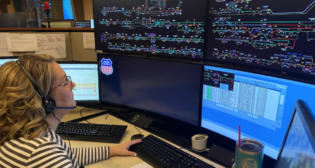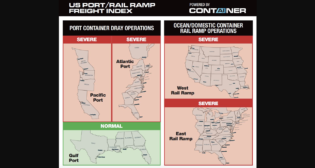
For NS, the Finish Line is Finally In Sight
Written by Rick Paterson, Managing Director, Loop Capital MarketsConcurrent with the political and public relations fallout from East Palestine, Norfolk Southern has been handicapped by a compromised network in terms of capacity and service, for the two reasons we’ve been discussing since March: A main line capacity bottleneck at East Palestine until the soil replacement/remediation is complete and both tracks are back in service and running at full speed, and the March change to more conservative train makeup standards, designed to reduce the incidence of derailments, which has primarily impacted NS’s non-intermodal businesses—for example, the placement of lighter weight empties at the back of a train consist and a greater use of distributed power.
The finish line is finally in sight, with Railway Age reporting that the second track through East Palestine was operational on June 26. What happens next?
Given the soil and ballast beneath the track was replaced, it takes a little while for the new roadbed to settle to the point where trains can run at full speed. NS has been running a small amount of tonnage over the line at reduced speeds until that happens. After that, post-July 4, trains will finally be able to run at normal speed on both tracks through East Palestine, and the re-routes that have been in place for months can be canceled. NS can finally resume running to plan and, operationally, will once again be in control of its own destiny.
The bottleneck elimination also eliminates the artificial ceiling on service metrics, which should exit Q3 in materially better shape (and consequently better margins and earnings). With the network no longer compromised, NS will now have an urgency to narrow the service gap with CSX as fast as possible. CSX has been running like a cat in a lightning storm (fast) since Thanksgiving , and there’s no doubt been some regional market share that has reacted to that. Game on.
After a pause, network velocity is resuming its pattern of incremental improvements and as of June 16 sat at a 15-week high; albeit still below where it was prior to East Palestine. Trains holding for crews deteriorated a little to 21 per day, from 18 the week prior, and trains holding for power remained in much better shape at seven per day. Remember the two issues here are the capacity bottleneck at East Palestine until the soil remediation is complete and both tracks are back in service and running at full speed in July, and the March change in train makeup standards, primarily impacting NS’s non-intermodal businesses.

The proportion of cars on line sitting idle for 48-hours or more has been flat at 3.2% as of June 16. It peaked at 6.0% in early April and ultimately needs to get back below 2% to fully normalize. Significantly, NS was able to reduce cars on line to a 16-week low, which sets up further network improvements in July. In terms of keeping it simple, NS’s financials won’t be satisfactory until the green and black arrows on the right-hand axis of the chart (above) swap places, with green lower than black. Traction on both should improve in July.

Trains holding for all reasons other than power and crews was a little better sequentially, from 32 to 28 per day. Terminal dwell had been basically flat for three weeks. The East Palestine bottleneck and changes in train makeup standards blew recrews out to 569 in the first week of April, but NS battled that down to 352. We’re lapping a meltdown from last year so the dark green lines in the charts need to be materially better than the light green ones. While both are now better YoY, the “materially” part should become more pronounced from mid-July as the East Palestine bottleneck disappears.

Private car-miles per day had also been flat for three weeks, at 92 miles, while manifest on-time performance had been hovering around 72% over that period. This measure hit 80% in some weeks in December/January, so better is possible and probable before the year is out. For perspective, manifest service represents about 57% of NS’s average daily train starts
Intermodal network speed rose 0.5 mph, while trains holding for all reasons remained comfortably low. On-time performance was flat at 99%. Also, a reminder that you can’t compare NS on-time performance numbers to UP and BNSF because NS is measuring when trains arrive on shorter hauls vs. when containers are unloaded on longer hauls for the western railroads. Slow-to-move intermodal platforms came in below 100 per week for six consecutive weeks and represented a low we haven’t seen since late 2020. NS did a good job largely mitigating the intermodal service hit from the East Palestine bottleneck.
Average coal train speed rose slightly while dwell at origin also improved a little. NS doesn’t report coal train on-time performance. Grain train speeds were softer. NS doesn’t report grain train on-time performance.



